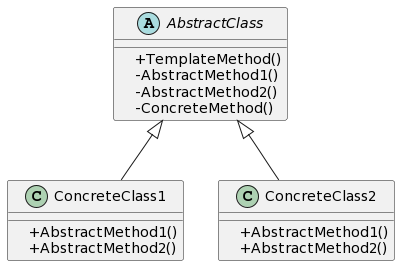1. What is the Template Method Pattern
In software development, the Template Method Pattern is a behavioral design pattern that defines the skeleton of an algorithm and defers some steps to be implemented in subclasses. This allows subclasses to implement their own behavior at specific steps without changing the algorithm's structure.
2. Features and Advantages of the Template Method Pattern
The features and advantages of the Template Method Pattern include:
- Defines the skeleton of an algorithm and defers the implementation of specific steps to subclasses.
- Allows subclasses to redefine certain steps of the algorithm without changing its structure.
- Provides a way to encapsulate the algorithm, making it independent of specific implementation details.
- Reduces code duplication and enhances code reusability.
3. Examples of Practical Applications of the Template Method Pattern
The Template Method Pattern has many practical applications in software development. Some typical examples include:
- Hook methods in frameworks: Hook methods provide extension points at certain steps of an algorithm, allowing subclasses to extend as needed.
- Template methods for database operations: For example, in database operations, connecting, opening transactions, executing SQL statements, closing connections, etc., can be abstracted as template methods to be implemented by subclasses.
- Event handling in GUI applications: Event handling in GUI applications often follows certain rules and processes, which can be implemented using the Template Method Pattern.
4. Implementation of the Template Method Pattern in Golang
4.1. UML Class Diagram

4.2. Example Introduction
In the example of the Template Method Pattern, there is an abstract class AbstractClass, which includes a template method TemplateMethod and some abstract methods AbstractMethod1 and AbstractMethod2. Concrete subclasses ConcreteClass1 and ConcreteClass2 inherit from AbstractClass and implement the specific abstract methods.
4.3. Implementation Step 1: Define the Abstract Template Class
First, we need to define an abstract template class AbstractClass, in which the template method and abstract methods are declared.
package main
import "fmt"
type AbstractClass interface {
TemplateMethod()
AbstractMethod1()
AbstractMethod2()
ConcreteMethod()
}
type BaseClass struct{}
func (b *BaseClass) TemplateMethod() {
b.AbstractMethod1()
b.AbstractMethod2()
b.ConcreteMethod()
}
func (b *BaseClass) ConcreteMethod() {
fmt.Println("Executing concrete method")
}
4.4. Implementation Step 2: Implementing Specific Template Classes
Next, we need to create specific template classes, such as ConcreteClass1 and ConcreteClass2, and implement the abstract methods in these classes.
type ConcreteClass1 struct {
*BaseClass
}
func NewConcreteClass1() *ConcreteClass1 {
return &ConcreteClass1{
&BaseClass{},
}
}
func (c *ConcreteClass1) AbstractMethod1() {
fmt.Println("Executing method1 of ConcreteClass1")
}
func (c *ConcreteClass1) AbstractMethod2() {
fmt.Println("Executing method2 of ConcreteClass1")
}
type ConcreteClass2 struct {
*BaseClass
}
func NewConcreteClass2() *ConcreteClass2 {
return &ConcreteClass2{
&BaseClass{},
}
}
func (c *ConcreteClass2) AbstractMethod1() {
fmt.Println("Executing method1 of ConcreteClass2")
}
func (c *ConcreteClass2) AbstractMethod2() {
fmt.Println("Executing method2 of ConcreteClass2")
}
4.5. Implementation Step 3: Defining Abstract and Concrete Methods
In the abstract template class, we need to define some abstract methods and concrete methods. The abstract methods are implemented by specific subclasses, and the concrete methods are called in the template method.
4.6. Implementation Step 4: Client Using Template Method
Finally, we can use the template method in the client code to implement specific business logic.
func main() {
class1 := NewConcreteClass1()
class1.TemplateMethod()
class2 := NewConcreteClass2()
class2.TemplateMethod()
}
4.7. Implementation Step 5: Execution Results
When we run the above code, we will get the following output:
Executing method1 of ConcreteClass1
Executing method2 of ConcreteClass1
Executing concrete method
Executing method1 of ConcreteClass2
Executing method2 of ConcreteClass2
Executing concrete method
The above is the implementation and usage example of the template method pattern in Golang. By using the template method pattern, we can encapsulate some common behaviors into an abstract class and allow specific subclasses to implement their specific behaviors, thereby improving code reusability and extensibility.
Conclusion
This tutorial introduced the template method pattern in Golang, including the definition, characteristics, and application scenarios of the pattern, and provided an implementation example. Through this example, we can clearly understand the specific implementation and usage of the template method pattern in Golang.